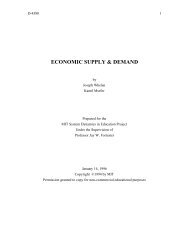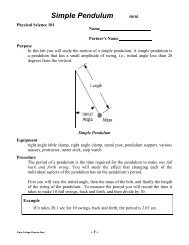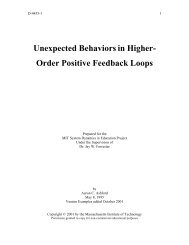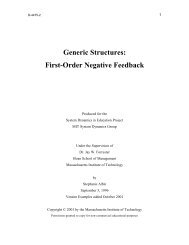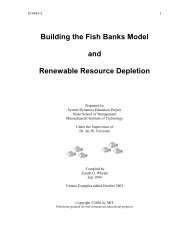Using a Model to estimate future carbon dioxide levels and possible ...
Using a Model to estimate future carbon dioxide levels and possible ...
Using a Model to estimate future carbon dioxide levels and possible ...
Create successful ePaper yourself
Turn your PDF publications into a flip-book with our unique Google optimized e-Paper software.
<strong>Model</strong>ing <strong>carbon</strong> <strong>dioxide</strong> concentration changes<strong>Using</strong> a <strong>Model</strong> <strong>to</strong> <strong>estimate</strong> <strong>future</strong> <strong>carbon</strong> <strong>dioxide</strong> <strong>levels</strong><strong>and</strong> <strong>possible</strong> global warming<strong>Model</strong> is located at:http://www.atmosedu.com/physlets/GlobalPollution/CO22011.htmQUESTIONSReal Data: Reading The Graph of Figure 1 (see link above <strong>to</strong> access Figure 1)Q1: Objective: How has the CO 2 concentration changed over the recent past?Read the graph of figure 1 <strong>to</strong> answer these questions (click on the image <strong>to</strong> enlarge it).What are the approximate global average annual average concentrations of CO 2 in 1960,1970, 1980, 1990, 2000?Year [CO 2 ] (ppm) [CO2] ppm1960 *******1970 1960s1980 1970s1990 1980s2000 1990s2010 2000sFrom these <strong>estimate</strong>d values is the rate of increase of CO 2 :Growing staying about the same decreasing [circle one]Discuss <strong>possible</strong> reasons for the behavior of atmospheric <strong>carbon</strong> <strong>dioxide</strong> concentration<strong>levels</strong> over the past 50 years.R. M. MacKay, Clark College Physics <strong>and</strong> Meteorology 1
<strong>Model</strong>ing <strong>carbon</strong> <strong>dioxide</strong> concentration changesThe simulation environment is based on the IPCC parameterization of the Bern <strong>Model</strong>.See http://www.atmosedu.com/physlets/GlobalPollution/CO22011.htm for links <strong>to</strong> amore detailed description. In the schematic above there are 4 major components of the ofthe global <strong>carbon</strong> cycle: Atmosphere, Biosphere, Surface Ocean, <strong>and</strong> Deep Ocean.LS,HS, HD in the above figure are Low latitude surface ocean, High latitude surfaceocean, <strong>and</strong> High latitude Deep Ocean. K is the vertical diffusion constant, q is thehorizontal diffusion in the deep ocean, u is the mean upwelling down-welling velocity,<strong>and</strong> w is the horizontal advection velocity in the surface layer.What important component <strong>to</strong> the <strong>carbon</strong> cycle is missing? Why has this componentbeen omitted in the IPCC model?R. M. MacKay, Clark College Physics <strong>and</strong> Meteorology 2
<strong>Model</strong>ing <strong>carbon</strong> <strong>dioxide</strong> concentration changesObjective: Learn how the different model inputs influence the behavior of CO 2 overtime.While in the model environmenthttp://www.atmosedu.com/physlets/GlobalPollution/CO22011.htmclick on “To RUN <strong>Model</strong> Window “Run the model with Co=300 ppm, S=5 Gt Carbon/yr , <strong>and</strong> R=0.0. Use the Run1 but<strong>to</strong>nso the curve is displayed in red. Call this the Control Run.Starting from the initial values of the Control Run <strong>and</strong> describe how the graph changeswhen:A. Co is increased <strong>to</strong> 340 (keep S= 5 Gt Carbon/yr <strong>and</strong> R=0.0)B. S drops <strong>to</strong> 2.5 Gt Carbon/yr. (use Co=300 ppm <strong>and</strong> R=0.0 so you’re comparingwith the Control Run)C. R increases <strong>to</strong> 2.0 ( Use Co=300 ppm <strong>and</strong> S=5 Gt Carbon/yr so you’recomparing with the Control Run)Each description above should discuss whether the graph shifts upward or downward,starts out steeper or not so steep, <strong>and</strong> becomes more curved or less curved than thestarting graph. Sketch the result of each change below. The black dots are the actualMauna Loa CO 2 data <strong>and</strong> should be ignored for now.A B CR. M. MacKay, Clark College Physics <strong>and</strong> Meteorology 3
<strong>Model</strong>ing <strong>carbon</strong> <strong>dioxide</strong> concentration changesObjective: Adjust model inputs <strong>to</strong> obtain a good fit between the model <strong>and</strong>observation of CO2 for the recent past. We do this for two reasons. 1. <strong>to</strong> see if themodel provides a plausible description of the real world for conditions of the recent pastup <strong>to</strong> the present, <strong>and</strong> 2. “calibrate” the model so we can <strong>estimate</strong> <strong>future</strong> concentrationsof atmospheric CO 2 with some confidence.Q2: Click on CO2#1 for this simulation. This shows the 1960 <strong>to</strong> 2010 annual meanMauna Loa data for CO 2 . Adjust the initial concentration, initial emission, <strong>and</strong> emissionincrease rate <strong>to</strong> get the best fit between model <strong>and</strong> observations.Hint: To get the best fit, first select the appropriate initial concentration, then using R=0%change the initial emissions <strong>to</strong> give a good fit for the first 5 years. After this you canfine-tune the fit for later years by changing R. Doing this should give you a very good fitbetween model simulations <strong>and</strong> observations. (the fit between model <strong>and</strong> observedvalues black dots should be very good)After getting a real good fit, record your values here:Initial Concentration (ppm): _____________Initial Emissions (ppm/yr): _____________Emission Growth Rate (%): _____________Objective: With the best fit what does the model predict for the year 2010concentration <strong>and</strong> emissions.Q3: Use the numerical output table of the model <strong>to</strong> record the year 2000 concentration(ppm)<strong>and</strong> year 2010 emissions (ppm/yr) for the best fit obtained in question 2Record these values here (include units).Year 2010 Concentration= _____________Year 2010 Emissions= _____________Objective: Estimate <strong>future</strong> CO2 concentration values, using values of the year 2010concentration <strong>and</strong> emission strength as initial conditions, for different assumed<strong>future</strong> emission growth rate R scenarios.Q4: Go <strong>to</strong> Run <strong>Model</strong> <strong>and</strong> click on CO2#2 which starts the model simulation from year2010 <strong>and</strong> runs it in<strong>to</strong> the <strong>future</strong> <strong>to</strong> the year 2110. Use your values of year 2010concentration, year 2010 emissions, <strong>and</strong> the emissions growth rate from question 2 <strong>to</strong><strong>estimate</strong> <strong>future</strong> concentrations of CO 2 . We are essentially using past performance <strong>to</strong>predict <strong>future</strong> behavior. Call this assumed emission rate increase the business as usualgrowth rate. Use the Run1 but<strong>to</strong>n for this run. When, if ever, does the concentrationreach 632 ppm (twice its 1959 value)? Time <strong>to</strong> get <strong>to</strong> 632ppm=_________________Record your answer in Table 1 below.R. M. MacKay, Clark College Physics <strong>and</strong> Meteorology 4
<strong>Model</strong>ing <strong>carbon</strong> <strong>dioxide</strong> concentration changesChange the emission growth rate <strong>to</strong> twice the business as usual value <strong>and</strong> run the modelagain as Run2. This corresponds <strong>to</strong> a tremendous <strong>future</strong> growth in energy usage <strong>and</strong>growth in CO 2 emissions (fossil fuel usage <strong>and</strong> deforestation). When if ever does theconcentration reach 632 ppm (twice its 1959 value)? Time <strong>to</strong> get <strong>to</strong> 632ppm=__________ Record your answer in Table 1 below.Change the emission growth rate <strong>to</strong> half the business as usual value <strong>and</strong> run the modelagain as Run3. This corresponds <strong>to</strong> a smaller <strong>future</strong> growth in energy usage <strong>and</strong> smallergrowth in CO 2 emissions. When if ever does the concentration reach 632 ppm (twice its1959 value)? If it doesn't get this high say so <strong>and</strong> give the maximum concentrationreached <strong>and</strong> the year this maximum was reached. Time <strong>to</strong> get <strong>to</strong> 632 ppm=_________Record your answer in Table 1 below.Change the emission growth rate <strong>to</strong> zero <strong>and</strong> run the model again as Run4.This corresponds <strong>to</strong> holding global energy usage <strong>and</strong> CO2 emissions <strong>to</strong> their year 2000values. When if ever does the concentration reach 632 ppm (twice its 1959 value)? If itdoesn't get this high say so <strong>and</strong> give the maximum concentration reached <strong>and</strong> the yearthis maximum was reached. Time <strong>to</strong> get <strong>to</strong> 632 ppm=____________ Record youranswer in Table 1 below.Change the emission growth rate <strong>to</strong> -1.0 % <strong>and</strong> run the model again as Run4.This corresponds <strong>to</strong> a reduction in global energy usage <strong>and</strong> CO2 emissions <strong>to</strong> their year2000 values. When if ever does the concentration reach 632 ppm (twice its 1959 value)?If it doesn't get this high say so <strong>and</strong> give the maximum concentration reached <strong>and</strong> theyear this maximum was reached. Time (if ever) <strong>to</strong> get <strong>to</strong> 632 ppm= =____________Record your answer in Table 1 below.Table 1. Summarize your above results below.Scenariotime <strong>to</strong> get <strong>to</strong> 632 ppmBusiness as usual emission growth rate:Twice the Business as usual emission growth rate:half the Business as usual emission growth rate:zero emission growth (emissions fixed at 2000 values)-1.0 % emission growth (reduce emissions)If you had <strong>to</strong> guess, when would you say that the CO2 concentration will double from its1960 value? Justify your answer.R. M. MacKay, Clark College Physics <strong>and</strong> Meteorology 5
<strong>Model</strong>ing <strong>carbon</strong> <strong>dioxide</strong> concentration changesRun the model again using three different emission growth rate scenarios. 1%,Business as usual (near 2%) , <strong>and</strong> 3% emission increase.Table 2. Summarize your above results below.Scenario 2030 [CO 2 ] (ppm) 2060 [CO 2 ] (ppm)2 % emission growth rate (close <strong>to</strong> Business as usual):1 % growth3 % growthHow do the 2030 concentrations compare for the three different scenarios that you ranabove?How do the 2060 concentrations compare for the three different scenarios that you ranabove?T/F the predicted 2030 concentration depends very strongly on the assumed emissionscenario.T/F the predicted 2060 concentration depends very strongly on the assumed emissionscenario.A policy change aimed at limiting <strong>carbon</strong> <strong>dioxide</strong> in the atmosphere that is implementedby a political agreement <strong>to</strong>day will take ____________ years <strong>to</strong> result in observabledifferences in the amount of <strong>carbon</strong> <strong>dioxide</strong> in the atmosphere.a. 5 yearsb. 10 yearsc. 20 yearsd. More than 20 yearsBased on your answers above <strong>and</strong> any other potentially important fac<strong>to</strong>rs, discuss thepolitical incentive <strong>to</strong> proposing legislation <strong>to</strong> curtail <strong>carbon</strong> emissions.Another interesting test is <strong>to</strong> see what negative growth rate is needed <strong>to</strong> keep theatmospheric CO2 concentration below 450 ppm.What growth rate is needed? Discuss the feasibility of achieving this growth rate in thenext 10 <strong>to</strong> 20 years.R. M. MacKay, Clark College Physics <strong>and</strong> Meteorology 6
<strong>Model</strong>ing <strong>carbon</strong> <strong>dioxide</strong> concentration changesOne last scenario which is unrealistic but interesting is <strong>to</strong> instantly cut global emissions <strong>to</strong>zero. The graph below shows the business as usual scenario. Sketch the behavior ofatmospheric CO2 from 2010 <strong>to</strong> 2110 with zero emissions.In your own words describe your results. Is this what you would expect?Objective: Use the above CO2 concentration profiles <strong>and</strong> the recent result from theIPCC (Intergovernmental Panel on Climate Change) <strong>to</strong> obtain <strong>estimate</strong>s of <strong>future</strong>global temperatures.For each assumed emission scenario <strong>estimate</strong> the 1960 <strong>to</strong> 2060 range in temperaturechange <strong>estimate</strong>d by current climate models. Do this by clicking on “To Scenarios”<strong>and</strong> then finding which scenario in the graph best fits the emission scenario your areexploring. Then click on the best-fit scenario <strong>to</strong> see the <strong>estimate</strong> in <strong>future</strong> temperaturepredicted by current climate models (2001 Intergovernmental Panel on Climate Changereport ).R. M. MacKay, Clark College Physics <strong>and</strong> Meteorology 7
<strong>Model</strong>ing <strong>carbon</strong> <strong>dioxide</strong> concentration changesTable 3. 1960 <strong>to</strong> 2060 <strong>estimate</strong>d range in temperature change for post 2010 emissionsmatching the:ScenarioBusiness as usual emission growth rate:1960 <strong>to</strong> 2060 <strong>estimate</strong>d rangein temperature changeTwice the Business as usual emission growth rate:half the Business as usual emission growth rate:zero emission growth (emissions fixed at 2010values)-1.0 % emission growth (reduce emissions)Write a paragraph or two describing which <strong>future</strong> emission scenario is most realistic forthe years 2010 <strong>to</strong> 2060 <strong>and</strong> why. Also state what you believe will be the largest plausible(1960 <strong>to</strong> 2060) change in global mean surface temperature <strong>and</strong> the smallest plausible(1960 <strong>to</strong> 2060) change in global mean surface temperature. Justify your reasoning in allcases.R. M. MacKay, Clark College Physics <strong>and</strong> Meteorology 8




